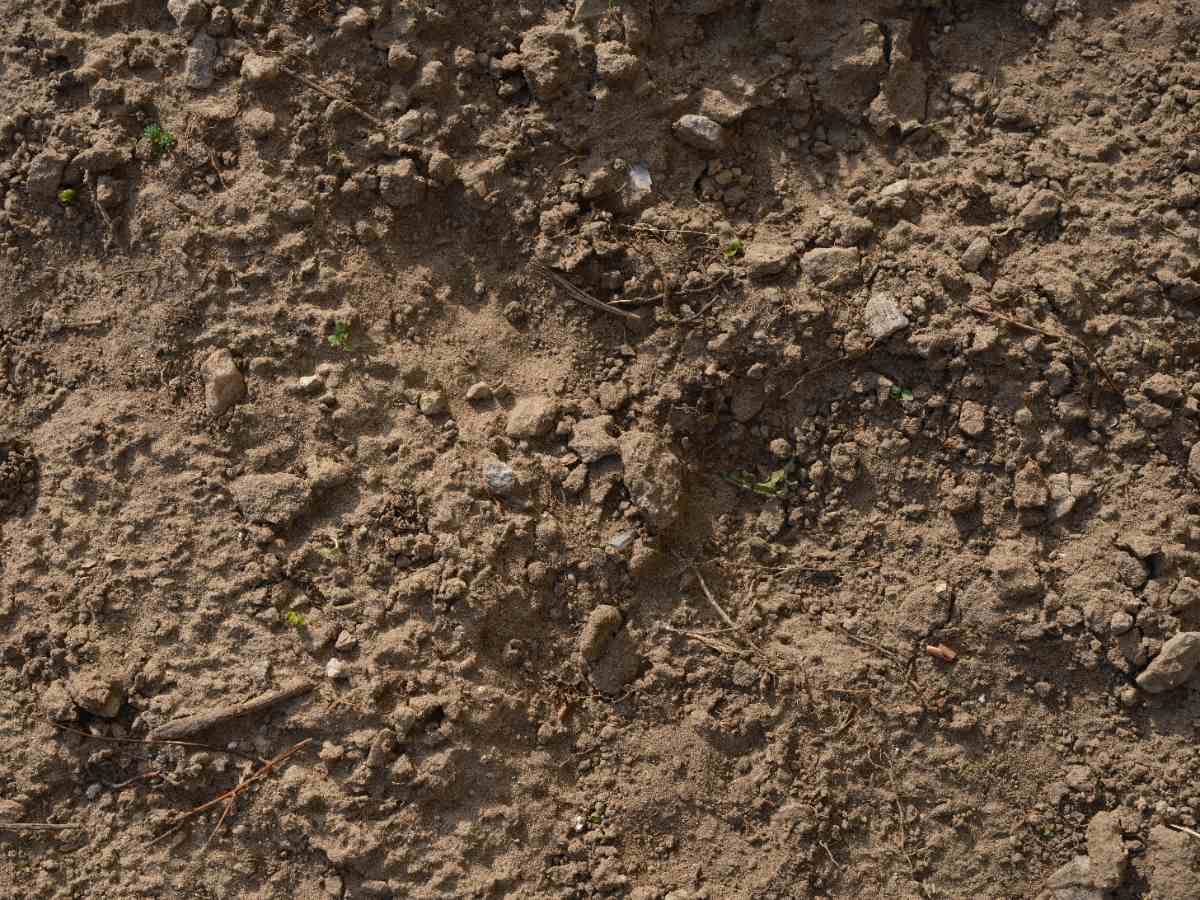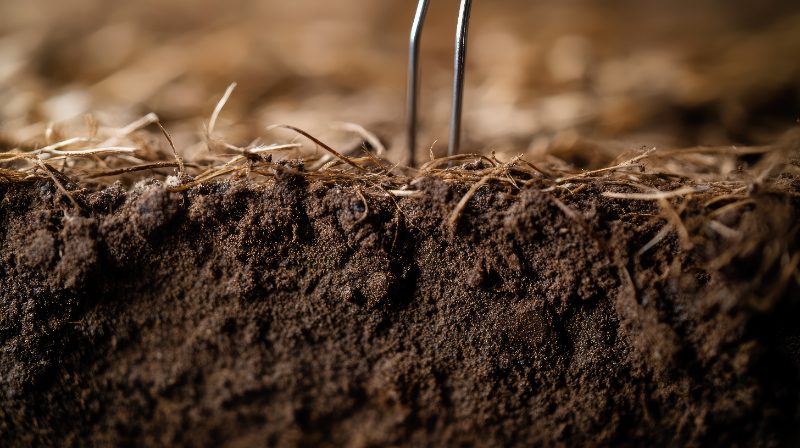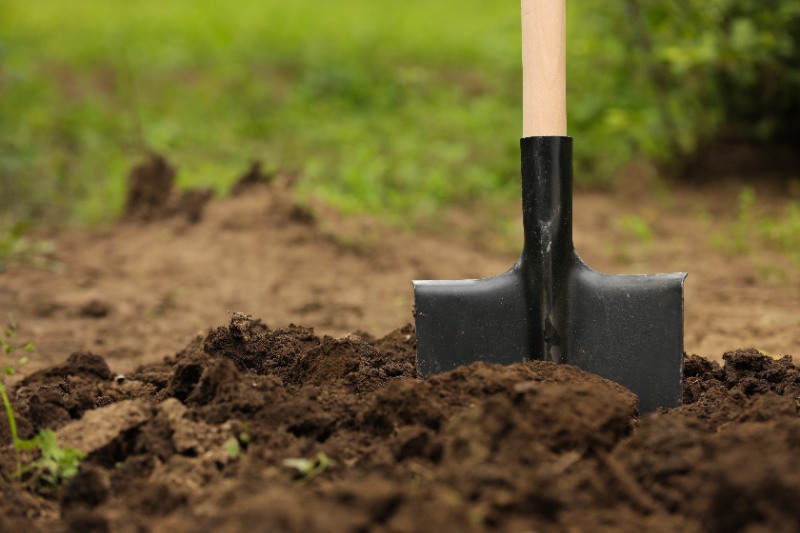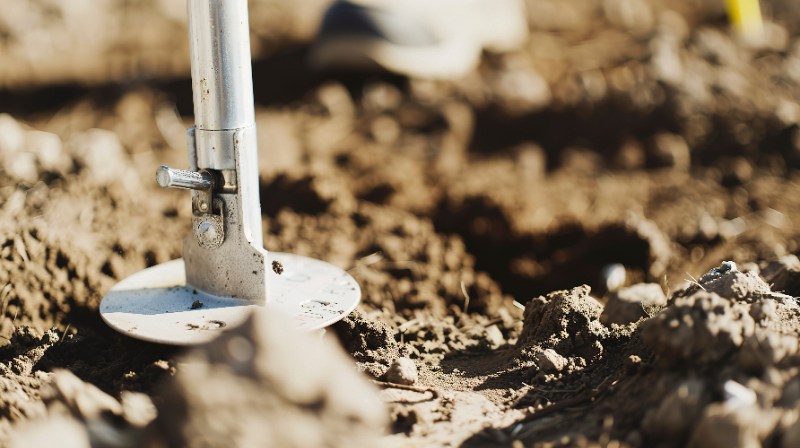
When soil is compacted, soil particles are packed tightly together, preventing spaces for water, nutrients, and air to flow into the soil. As a result, your lawn and plants won’t be able to access the resources they need.
To have a healthy lawn, you need to know how to test for compacted soil, whether that be with a screwdriver or probing your soil with a penetrometer.
Note: Test your soil in a zig-zag pattern across multiple areas around your yard; don’t just test the soil in one spot. Otherwise, you will not be able to accurately assess the level of soil compaction across your yard.
Wire Flag Test

A wire flag can be used as a soil probe. By sticking the rod of the wire flag into dirt, the resistance it encounters will alert you to soil compaction.
What you need:
- Wire flag (or a wire coat hanger)
- Measuring tape
How to do it:
- Hold the wire flag at the flag end and stick it into the ground.
- Push the wire flag in as far as it can go before the wire starts bending.
- Mark the depth at which the wire bends.
Interpret the results:
- If you push the flag into the soil 4 to 12 inches without bending the wire, it means the soil is loose. Ideally, you should be able to stick the wire in 1 foot before it starts to bend.
- If the wire begins to bend at 4 inches, the soil is compacted.
Pro Tip: Objects such as rocks or pipes can block the wire, so make sure you accurately identify the problem. Don’t mistake a buried object for soil compaction.
If you’ve discovered that your soil is compacted, aeration works to alleviate compacted soil. Don’t wait to fix compacted soil in your yard; contact a LawnStarter pro today to aerate your soil.
See Related: How to Fix Compacted Soil
Shovel Test

One of the best ways to test for compacted soil is to stick a shovel into the soil.
What you need:
How to do it:
Only try this method when the soil is moist. Dry soil is hard, so it will be harder to tell if the soil is compacted or simply hardened from dryness.
- Wait 2 to 3 days after rainfall or irrigation.
- Stick your shovel or a similar tool in the soil.
Interpret the results:
You should be able to stick your shovel into the soil with relative ease. If you meet a lot of resistance or have a lot of difficulty penetrating the earth with a shovel, you are likely dealing with compacted soil.
See Related: How to Test Soil Moisture
Screwdriver Test
One of the simplest and quickest ways to determine if your soil is compacted is to stick a screwdriver into the ground.
What you need:
- A 4-inch or 6-inch screwdriver
How to do it:
Stick a screwdriver into the soil as far as you can.
Interpret the results:
- You should be able to slide the rod of the screwdriver all the way into the soil up to its handle. If the screwdriver slides into the soil easily, you have loose soil.
- If you encounter a lot of resistance or are unable to fully push the screwdriver into the ground, it means you have compacted soil.
Static Cone Penetrometer Testing

A penetrometer is a probe with a cone-shaped tip that consists of a pressure gauge on top of a rod. It provides a measurement of the resistance in the soil.
What you need:
- A penetrometer (can be purchased on Amazon or from certain suppliers)
How to do it:
To conduct a soil compaction test, you must stick the penetrometer rod in the soil in areas where you suspect soil compaction. Wait 2 to 3 days after rain or irrigation to perform the test.
- Push the penetrometer about 6-12 inches deep into the soil. A digital penetrometer usually has markings every 3 to 4 inches indicating how far it sinks into the soil.
- Measure the resistance as you push the penetrometer into the soil. Push the rod into the ground at a steady, consistent rate. Aim for 1 inch per second.
- Repeat the test in multiple places to confirm your yard has compacted soil. For an average lawn, take at least 3 readings.
Soil texture and moisture levels are other factors that affect how compacted your soil is. To prevent these factors from interfering with a soil test, allow the soil to dry out for 2 to 3 days after rain. Also, know that clay and silty soils have a higher bulk density, so they are more prone to compaction.
Interpret the results:
The readings taken with a penetrometer are called the cone index. The higher the resistance in the soil, the higher the soil compaction.
Here’s how to interpret the measurements of a penetrometer:
- Under 200 pounds per square inch (PSI): Loose, well-drained soil
- 200-300 pounds per square inch: Some compaction
- Over 300 pounds per square inch: High compaction. Root growth stops at 300 PSI due to soil compaction.
The deeper the penetrometer can go with a lower reading, the less compact the soil is.
See Related: Guide to Soil Types
Visual Analysis
By visually examining the layers of soil to assess its structure, texture, and color, you can determine if you have compacted soil.
What you need:
- A shovel or trowel
- A plate or surface where you can place a slice of dirt
How to do it:
Excavate a vertical slice of your soil. It needs to be big enough that it will stay together long enough for you to study it, about the size of a soup can.
Set the soil slice on the plate or in a place where you can study it. Look for identifying characteristics in the layers of the soil that indicate compaction, such as:
- A lack of root growth/development
- Big, deformed aggregates (soil particles that bind together to form small clumps of dirt)
- Dense, compacted layers of soil surrounded by looser layers of soil
Interpret the results:
Visible evidence of compaction is evidence of soil compaction in your yard.
FAQ About Testing for Compacted Soil
Watch out for these signs that your soil is compacted:
• Increased erosion. Compacted soil creates more stormwater runoff during rainfall, which increases erosion.
• Fertilizer or soil amendments don’t have much effect. Compacted soil prevents nutrients from entering the soil, stopping them from improving your plants and soil.
• Decreased health of plants. Compacted soil prevents healthy root growth.
• Poor drainage. Compacted soil doesn’t drain well, which can cause standing water in your yard.
See Related:
• 5 Tell-Tale Signs Your Lawn Needs Fertilizer
• How to Control Erosion in the Yard
• 7 Ways to Improve Drainage in Your Yard
The best time of year to test for compacted soil is in the spring. Ideally, test for compacted soil 2 to 3 days after a soaking rain. Don’t test soil when it is muddy; otherwise, you may not be able to accurately measure soil compaction.
Test your soil for compaction every 3 to 5 years or whenever you suspect compaction. If your yard frequently encounters heavy foot traffic or lawn machinery, you might want to test once per year.
It isn’t impossible for grass seeds to grow in compacted soil, but compacted soil stunts healthy root growth, making it difficult for grass seeds to grow. If your yard has compacted soil, aerate the soil before you overseed.
Ready for a Healthy Lawn?
There are many ways to test for compacted soil. You can use tools around the home, like a screwdriver or a wire flag, to probe the earth, or you can use a penetrometer to measure compaction in your soil.
Without loose, healthy soil, your grass and other yard plants won’t be able to access the nutrients they need. Don’t hesitate to find a lawn aeration service today to fix the compacted soil in your yard.
Read More:
Sources:
- “Assessing and Addressing Soil Compaction in Your Yard.” By Steve Yergeau, county agent II of agriculture and natural resources, Christine Raabe, director of Ocean County soil conservation district, and Stephanie Murphy, director of Rutgers Soil Testing Laboratory. New Jersey Agricultural Experiment Station.
- “Diagnosing Soil Compaction Using a Penetrometer.” By Sjoerd Willem Duiker, professor of soil management and applied soil physics. Penn State Extension.
Main Image Credit: Stanislav / Adobe Stock